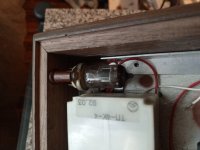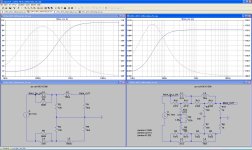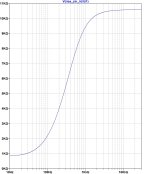Appropriate cascodes or pentodes can drive low impedance L(C)R RIAA networks; gain will suffer however:
https://www.diyaudio.com/community/...stage-with-the-s-b-10k-lcr-riaa-module.50910/
https://www.diyaudio.com/community/...stage-with-the-s-b-10k-lcr-riaa-module.50910/
It looks like there are negative grid bias supplies, labeled "U1-", "U2-", "U3-".Why no cathode resistors? There is nothing to linearise the response.
Or were you suggesting adding cathode degeneration on top of what's there?
I supply these voltages from a separate source made on a 6X2P lamp, these are 2 diodes ."U1-", "U2-", "U3-".
Attachments
You are right, the circuit is in the running-in stage. I will try to connect the LR section to the secondary winding of the transformer of the ECC88 lamp.you want to go with a 12SC7 into an LR network? This tube has a plate resistance >50k
I think it does not work in the way you do it. You need to clarify the theory in advance! Are you familiar with the math of LR networks? What about your inductors stray capacitance and leakage inductance? The inductance must be absolutely stable over the whole frequency range.
If you have a 10k LR network (very hard to get the inductors right) then the driving source impedance is essential that this network is working properly. Best is to simulate it. But at least you need to measure the frequency response with a feeding inverse RIAA network. You may even need a step-down xfmr for the ECC88 as it still has a very high internal impedance.
If you have a 10k LR network (very hard to get the inductors right) then the driving source impedance is essential that this network is working properly. Best is to simulate it. But at least you need to measure the frequency response with a feeding inverse RIAA network. You may even need a step-down xfmr for the ECC88 as it still has a very high internal impedance.
@docali
In 2005 Thorsten Loesch wrote:
The first thing to understand is that these networks are constant impedance T-Networks. In other words, they operate in a constant impedance environment and themselves present a constant impedance load at their nominal impedance (600R/10K).
This means in a "classical" situation the RIAA would be terminated with it's nominal impedance on either side, in other words the source impedance of the receeding stage would be made equal to the RIAA Modules and the RIAA Module would be loaded with it's nominal impedance.
In practice one of the terminations can be omitted, but NOT both. This means you either operate the RIAA Module with a near infinite load impedance and from a source impedance equal to it's nominal impedance.
OR you load the RIAA with it's nominal impedance and then you are free to select the source impedance with impunity.
Now, is an LCR a constant impedance T-network, and an LR not?
About the need for inductances being stable over the whole frequency range.....that would mean that:
Good equalizing networks are possible with less ideal inductances.
In 2005 Thorsten Loesch wrote:
The first thing to understand is that these networks are constant impedance T-Networks. In other words, they operate in a constant impedance environment and themselves present a constant impedance load at their nominal impedance (600R/10K).
This means in a "classical" situation the RIAA would be terminated with it's nominal impedance on either side, in other words the source impedance of the receeding stage would be made equal to the RIAA Modules and the RIAA Module would be loaded with it's nominal impedance.
In practice one of the terminations can be omitted, but NOT both. This means you either operate the RIAA Module with a near infinite load impedance and from a source impedance equal to it's nominal impedance.
OR you load the RIAA with it's nominal impedance and then you are free to select the source impedance with impunity.
Now, is an LCR a constant impedance T-network, and an LR not?
About the need for inductances being stable over the whole frequency range.....that would mean that:
- core permeability must be constant over the whole frequency range which, even with modern high permeability core material, is not the case, or
- air-gapped cores must be used to flatten out permeability, requiring larger cores.
Good equalizing networks are possible with less ideal inductances.
About inductors. This work was in close collaboration with Sowter:@docali
In 2005 Thorsten Loesch wrote:
The first thing to understand is that these networks are constant impedance T-Networks. In other words, they operate in a constant impedance environment and themselves present a constant impedance load at their nominal impedance (600R/10K).
This means in a "classical" situation the RIAA would be terminated with it's nominal impedance on either side, in other words the source impedance of the receeding stage would be made equal to the RIAA Modules and the RIAA Module would be loaded with it's nominal impedance.
In practice one of the terminations can be omitted, but NOT both. This means you either operate the RIAA Module with a near infinite load impedance and from a source impedance equal to it's nominal impedance.
OR you load the RIAA with it's nominal impedance and then you are free to select the source impedance with impunity.
Now, is an LCR a constant impedance T-network, and an LR not?
About the need for inductances being stable over the whole frequency range.....that would mean that:
I have been experimenting with these inductances, and the need for "being constant over the whole frequency range" is not 100% necessary.
- core permeability must be constant over the whole frequency range which, even with modern high permeability core material, is not the case, or
- air-gapped cores must be used to flatten out permeability, requiring larger cores.
Good equalizing networks are possible with less ideal inductances.
https://www.sowter.co.uk/pdf/LCR-RIAA Ahlswede.pdf
- Home
- Source & Line
- Analogue Source
- RIAA Phono LR correction


